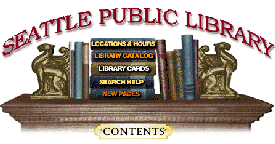The Context

As technology is changing rapidly, libraries must adapt to the realities of shifting technical environments. So, too, they must adapt to new environments resulting from changes in leadership. At the Seattle Public Library, important leadership changes have taken place since Council staff members visited in May 1996. The library director resigned in August 1996, and since then the director of the library’s Center for Technology in the Public Library has moved on to begin a new project elsewhere. Instead of analyzing the forces that lead to changes in leadership, we have chosen to present our snapshot of the Seattle Public Library as it was taken at the time of the Council’s staff visit.
The mission of the Seattle Public Library is to provide broader public access to its vast resources, and to promote lifelong learning and a love of reading. The library’s mission statement reflects its desire to be responsive to community needs. “We exist to serve our customers and we need to be flexible to find ways to do it,” said City Librarian Liz Stroup when the Council staff visited Seattle.
In its brochure, the Seattle Public Library describes itself as “one of the busiest urban public libraries in the country.” In 1994, the library circulated 5.2 million books and other items (10 per person in the city) and answered 1.43 million reference questions. It serves a population of 532,900 (1995 estimate) through a central library downtown, 22 branches, bookmobiles, and online services. The city of Seattle funds the library. In Washington, where there is no state income tax, there is also no state funding for public libraries. The library is governed by a five-member citizen’s Board of Trustees appointed by the Mayor and confirmed by the City Council.
At the Seattle Public Library “serving those who need us most” is a priority. The library has highly visible programs serving teens who drop out of school, teenage mothers and their children, those who are learning English, those who are learning to read, those who have handicaps that prevent them from reading without assistance, the homeless, the unemployed, and economically disadvantaged children who need homework help. The library holds “those who need us most” at the center of program development. It tries to acknowledge and serve the multiple cultures of the city, the most visible of which are the growing African American and Asian American populations. Greater awareness of the considerable needs and cultural diversity within the community has produced an environment in which experimentation is sanctioned as a way of determining which services or information resources might be most effective in specific neighborhoods or for specific groups of people. As a result, programs and services have multiplied. The library’s approach to delivering information electronically is guided by the same understanding that different approaches may be required to serve different audiences.
“Literacy is crucial to the role of libraries,” Stroup says, noting that 70,000 Seattle residents are functionally illiterate. With many recent immigrants to the city, waiting lists are long for courses offered by the community colleges in English as a second language. The Seattle Public Library views initiatives for literacy, reading, and technology as interrelated. The library has established a ten-million-dollar endowment fund from which it uses the income to operate three centers for research and outreach: the Center for the Book, the Center for Literacy Advocacy, and the Center for Technology in the Public Library. Through these centers, the library can try out programs that use new approaches to address community needs. The centers provide the library with experience upon which to base decision making about programs and services.

